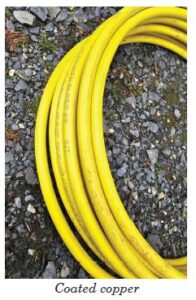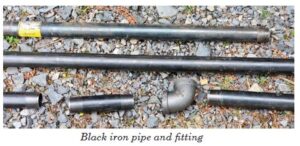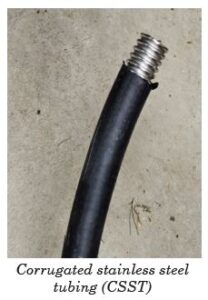Written on: May 1, 2023 by Alan Carver

In this article, we are going to take a look at various types of propane lines that can be used for different applications on a propane system installation. There are several different types; all have their own niche, as well as pros and cons.
Copper Pipe
Probably the most used and most versatile is copper. Today, we mainly use coated copper, which has a tough, typically yellow plastic, coating around it. The plastic coating “jacket” serves two purposes. First, it helps protect against corrosion and discoloration from the elements. Second, it helps protect the copper from abrasions. For example, if you were to run uncoated copper through a concrete or brick wall, you would have to run it through a conduit, so the copper line doesn’t rub and possibly wear a cut through the line. With coated copper, you can run the line right through the wall.

Overall, copper is the preferred material for propane installations. It can be used indoors or outdoors, above ground or buried. It will not rust in the elements like iron. It is also pliable and therefore can be bent and curved into position (within reason). One drawback, however, is that copper does not carry as much flow/pressure as some other materials.
For example, if you look at ½ inch copper and ½ inch black iron, there is a noticeable difference in size. Copper is measured by outside diameter, while iron pipe is measured by inside diameter. Copper’s smaller inside diameter carries less volume of gas downstream to the unit. Due to this, copper can be used on smaller units, such as propane fireplaces and cook stoves, at low pressure. We do, however, use copper in two-stage systems on the high-pressure side, such as 10PSI, before we get to the second-stage regulator and reduce the pressure. Copper is a great multi-use material, with its main downside being the lesser volume of flow it can carry.
Iron Pipe
Iron pipe generally comes in three types: black iron, galvanized and stainless steel. All are the same size and diameter, just with different finishes.
Unlike copper, black iron can carry much more volume. Generally, black iron is located after the second stage regulator on the low-pressure side and is used to carry a greater volume of gas. You will often see black iron or stainless steel coming off a pool heater or a generator where the British Thermal Units (BTUs) of these units are so high that a bigger line is needed to feed the necessary gas volume. It is also used in many other applications, such as coming off a furnace and other large BTU units.

Like copper, iron pipe has drawbacks, as well. For example, black iron rusts quickly when used outdoors. It can be painted to help mitigate any rust issues. Also, black iron cannot be directly buried in the ground. Therefore, many companies will use stainless-steel pipe in outdoor applications instead.
A quick side note on iron piping: If gas vapor is passing through it, Schedule 40 pipe is what is used. However, if liquid propane is going through it, Schedule 80 pipe must be used.
CSST Piping
Now let’s look at a “relatively” new material—corrugated stainless steel tubing (CSST); this material has become quite popular over the last few years. Like most piping, it has its pros and cons.
The pros: it too is measured by inside diameter, so it does not carry quite the flow that iron piping does; however, it carries more than copper lines do. It is also flexible; where iron pipe may not work because it is too rigid to snake through certain areas, CSST can work. Also, when the product first came out, it was against code to directly bury it. However, TracPipe® has come out with a CSST that is specifically designed for direct burial.

The cons: CSST, like the others, has drawbacks. The walls of the steel, although flexible, are thin.
When this material was first introduced, it was susceptible to lightning strike puncture. Companies such as TracPipe® have attempted to counteract this with a new version called Counter Strike®, which according to the company, reduces the potential for lighting-related damage. We currently use this, but our local codes still require us to bond the line back to the panel box in the customer’s house.
Polyethylene Pipe: “Poly”
This type of line coins the phrase “Do one thing and do it well.” There is only one application where this type of line can be used—it must be outdoors and buried in the ground. It is not UV-rated and therefore can only be used underground. Where the line breaks the surface, special risers are put over the “Poly” itself to connect to the tank or unit. Although this material is easy to work with, there are steps and measures that must be taken during installation. First, we put down sand or screenings on the bottom of the trench, then a bit of screenings/sand on top. Tracer wire is run along the entire length of the poly. This is because the material is plastic and not metal, and if someone had to dig, a metal detector would not be able to detect the line. Several additional inches of dirt go on top and we then run caution tape along the length of the line; we then fill the rest of the trench with dirt. The idea behind the caution tape is that, if someone was to dig, they would hit the tape first before hitting the line. Poly is a very good line that carries high volume for long distances, but must only be used in this exact application.
When using poly, keep in mind there are two different sizings, which are unique with poly, known as IPS and CTS. IPS is measured by inside diameter, which is larger. CTS is measured by outside diameter like copper tubing.
Summary
We use all the materials (line sets) mentioned here on a regular basis. They are all useful and have a role to play in propane installation. It is imperative to know and become familiar with all types of line sets in order to maximize the efficiency of a propane installation while maintaining the highest safety standards. As always, be sure to follow all local and NFPA58 and NFPA54 codes and guidelines on installations. ICM